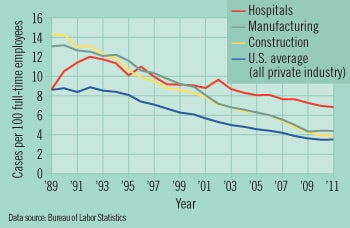OSHA steps up health care inspections
 While significant progress is being made, working in a hospital or health care facility still can be hazardous to your health.
While significant progress is being made, working in a hospital or health care facility still can be hazardous to your health.
In 2013, U.S. hospitals recorded 244,800 work-related injuries and illnesses, a total case rate of 6.4 work-related injuries and illnesses for every 100 full-time employees, according to the Bureau of Labor Statistics (BLS). That is almost twice as high as the rate for private industry as a whole for all U.S. industries, BLS states.
Additionally, 57,680 cases involving health care workers resulted in lost workdays.
In response, the Occupational Safety and Health Administration (OSHA) is targeting some of the most common causes of workplace injuries and illnesses in health care during its inspections.
OSHA advised its staff through a memorandum issued this past summer that all inspections of hospitals and nursing home facilities, including those prompted by complaints, referrals or severe injury reports, should include the review of potential hazards, especially musculoskeletal disorders (MSD). Other areas of focus include workplace violence; bloodborne pathogens; tuberculosis; and slips, trips and falls, the agency states.
“Workers in hospitals, nursing homes and long-term care facilities have work injury and illness rates that are among the highest in the country,” says David Michaels, assistant secretary of labor, OSHA.
BLS data show that 44 percent of all reported injuries in the health care industry were attributed to overexertion or MSD incidents commonly related to patient handling. In 2013, orderlies, nursing assistants and personal care aides continued to have some of the highest MSD rates of all occupations.
“The most recent statistics tell us that almost half of all reported injuries in the health care industry were attributed to overexertion and related tasks. Nurses and nursing assistants each accounted for a substantial share of this total,” Michaels says.
Workplace violence continues to be a serious issue for health care. Thirteen percent of injuries and illnesses were the result of violence, and the rate increased for the second year in a row to 16.2 cases per 10,000 full-time workers in 2013, up from 15.1 in 2012.
Matthew Linton, counsel for law firm Holland & Hart LLP, Denver, says one of the best safeguards a hospital can take in advance of an OSHA inspection is to conduct a self-audit to determine the strength of workplace safety in a facility and to have documented that workplace safety training is ongoing.
Inspections usually occur after an anonymous complaint has been made or a violent incident has been reported, according to the Department of Labor. While citations rarely exceed a few thousand dollars, mitigating an OSHA violation can be costly, Linton warns.
OSHA offers online assistance to help hospitals comply.




